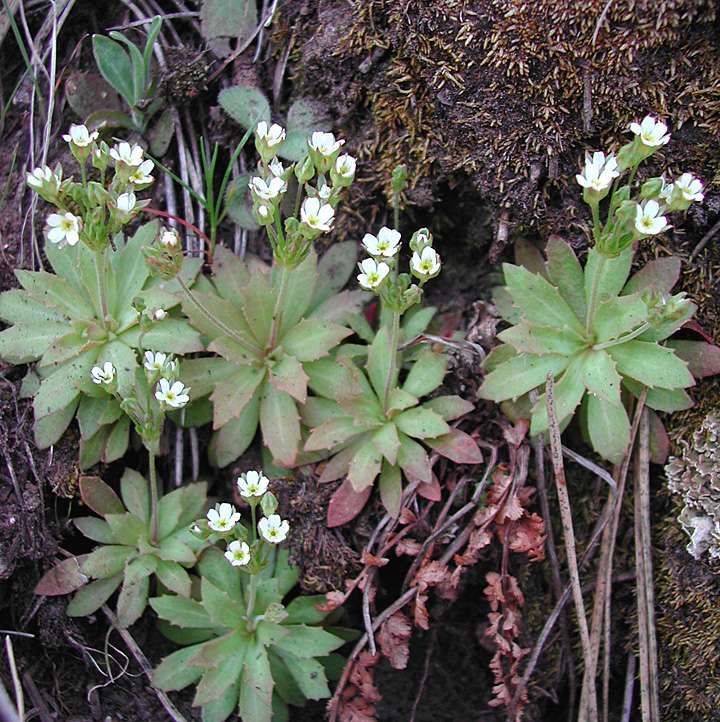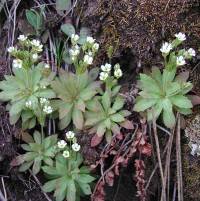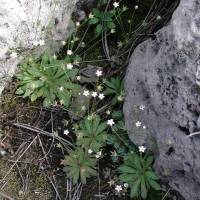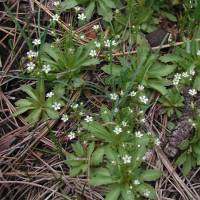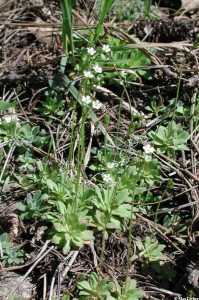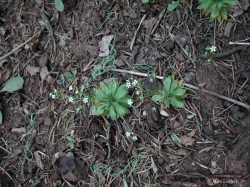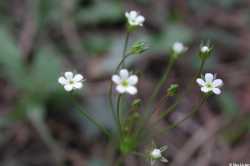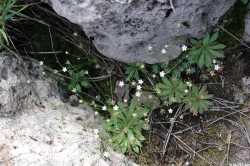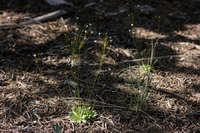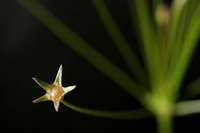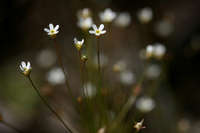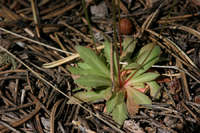Plants annual or biennial, highly variable in size from inconspicuous to moderately robust, not mat-forming. Leaves in single rosette; petiole obscure to absent; blade oblanceolate to spatulate, 5-30 × 3-10 mm, base obscurely narrowing to stem, margins often ciliate, surfaces glabrescent to hairy, hairs straight. Scapes 1-5(-10), 1-10(-15) cm, glabrescent, puberulent, or, sometimes, stipitate-glandular. Inflorescences 5-20-flowered; involucral bracts narrowly lanceolate to linear-lanceolate, relatively narrow. Pedicels erect to arcuate, slender, unequal, 0.3-6 cm. Flowers: calyx narrowly campanulate, with prominent ridges, 3-5 mm, lobes erect, broadly lanceolate, apex acute; corolla tube equaling or shorter than calyx, limb to ca. 3 mm diam. Capsules ± equaling calyx, 3-5 mm. 2n = 20.
Flowering spring-early fall. Open areas with sandy, gravelly soil in grassland, shrub, forest, and tundra communities; 0-3500 m; Greenland; Alta., B.C., Man., Nfld. and Labr. (Nfld.), N.W.T., Nunavut, Ont., Que., Sask., Yukon; Alaska, Ariz., Calif., Colo., Idaho, Minn., Mont., Nev., N.Mex., N.Dak., Oreg., S.Dak., Tex., Utah, Wash., Wyo.; Eurasia.
Plant: small herbacious plant; 1-30 cm tall
Leaves: 5-20 mm long, sessile; blades lanceolate, glabrous to pubescent
INFLORESCENCE: with lanceolate to linear-lanceolate bracts
Flowers: white or pink; calyx 2.7-4.7 mm long, glabrous or with occasional white or reddish-brown hairs, the lobes shorter than or barely equalling the tube; corolla longer than or equal to the calyx
Fruit: FRUITS valvate
Misc: -Gravelly streambeds, springs and moist meadows, mountain parks, open coniferous forests, and rocky alpine tundra; 1500-3650 m (5000-12000 ft); Apr-Sep
REFERENCES: Cholewa Anita F. 1992. Primulaceae. Ariz.-Nev. Acad. Sci. 26(1)2
Duration: Annual
Nativity: Native
Lifeform: Forb/Herb
General: Delicate upright, annual 1-30 cm tall, with a clustered stem.
Leaves: Basal, with blades 5-20 mm long, sessile, blades lanceolate, glabrous to pubescent.
Flowers: Inflorescence with lanceolate to linear-lanceolate bracts; white or pink flowers; calyx 2.7-4.7 mm long, glabrous or with occasional white or reddish-brown hairs, the lobes shorter than or barely equaling tube; corolla longer than or equal to the calyx.
Fruits: Valvate capsule.
Ecology: Found on gravelly stream beds, in moist ground of springs or meadows, mountain parks, or open coniferous forests from 5,000-12,000 ft (1524-3658 m); flowers April-September.
Notes: Told apart from A. occidentalis by the lanceolate to linear-lanceolate involucral bracts, and the corolla being longer than the calyx. The former is also found at all the lower elevation from 1000-8000 ft (305-2438 m).
Ethnobotany: Taken for internal pain, as a life medicine, for venereal disease, as protection from witches, and sometimes steeped to make a beverage.
Etymology: Androsace from Green name for sea-plant from Greek andros, a man, male and sakos, a shield, while septentrionalis means or or pertaining to the north.
Synonyms: Androsace septentrionalis subsp. subulifera, Androsace diffusa, Androsace septentrionalis var. diffusa, Androsace septentrionalis var. subulifera
Editor: SBuckley, 2010
Lvs oblanceolate, 1-3 cm, toothed or entire, sparsely to densely hairy with simple or forked hairs; scapes usually many, to 10+ cm, usually ±densely hairy with fine, branched hairs; umbels 3-25-fld, the bracts lanceolate or subulate, 1-3 mm, at least 4 times as long as wide; cal 2.5-4 mm, strongly carinate, the tube evidently longer than the ±deltoid lobes; cor white, the tube shortly exsert, the limb 3-4 mm wide; 2n=20. Circumboreal and polymorphic, extending s. to Que., Minn., and Ariz. May, June. (A. puberulenta)
Gleason, Henry A. & Cronquist, Arthur J. 1991. Manual of vascular plants of northeastern United States and adjacent Canada. lxxv + 910 pp.
©The New York Botanical Garden. All rights reserved. Used by permission.


